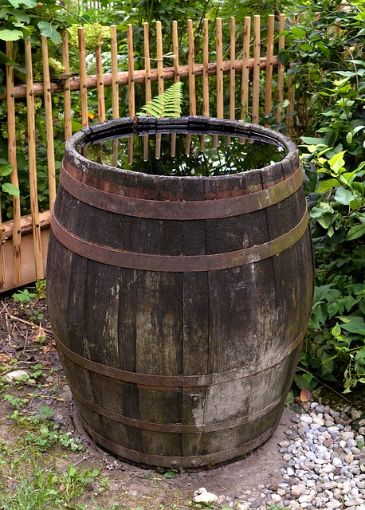Harvesting rain water: nature’s bounty
July 17, 2020
53 inches! 53 inches of rain on average per year in Lee County! According to the Lee County rain gauge data, June is typically the wettest month, averaging about 9 inches of rain, while August is the rainiest month with approximately 17 rain days. As gardeners, we often wish we could reserve some of that rainfall for the very hot, dry days throughout the year. We may not be able to control nature, but we can nurture our gardens with harvested rain water, collected and saved during rainy season.
Many gardeners are fortunate to have rain barrels for this purpose. Rain barrels are a low-cost way to collect rain water from our rooftops and store it for hand watering or drip irrigation on dry days. One inch of rain from a small 1,000-square-foot roof can deliver over 500 gallons of water. Although this water is not filtered or treated to use for drinking or cooking, it is acceptable for watering indoor and outdoor plants. In fact, scientists from Washington State, New Jersey and Australia have studied rooftop run-off for pollutants and have found that the water is "surprisingly clean" and safe for watering edibles especially when the water is directed to the soil first. However, they recommended that rain water from treated wood-shake roofs, copper roofs, zinc roofs or roofs treated with toxic chemicals not be used for watering edibles.
That being said, rain barrels offer several benefits to the home gardener. First, if reclaimed city water is not accessible to you, having a rain barrel will save you money on your water bill. Second, you can water from your rain barrel as you need to without worrying about irrigation schedules and restrictions. Third, plants prefer rain water since tap water contains chlorine, fluorides and salt. All of which can stunt the growth of your plants. As an aside, if you must use tap water, fill your buckets and let them sit out for 24 hours so the chlorine and fluoride can dissipate.
Harvested rainwater can also be used to fill ponds and bird feeders, creating a freshwater oasis for migrating birds, butterflies and wildlife. In addition, rain barrel collection systems have an overflow feature that can direct excessive water to your garden or, better yet, a rain garden. This feature will help to "slow the flow" of stormwater runoff, thereby protecting our groundwater from the pollutants that are washed off our landscapes into our nearby waterways.
Some tips: Plan the placement of your rain barrel near a downspout in an area accessible to your garden. Use a tight-fitting lid and downspout to keep mosquitoes out of your barrel or add about 2 teaspoons of vegetable oil to the barrel creating a surface area that keeps mosquitoes from laying eggs there. Although not required, you can paint your rain barrel. You can keep it simple and paint it to match your home or you can be creative and add an artistic touch.
Rain barrels are available locally and online. For specific details and more tips, you can join the next rain barrel workshop hosted by Cape Coral Parks and Recreation in conjunction with the Lee County Master Gardeners. This virtual workshop is scheduled for July 25 at 10 a.m. Registration is $45 and includes a completely assembled rain barrel that can be picked up at Rotary Park in Cape Coral. To register, please call the Rotary Park office at 239-549-4606.
Happy Gardening & Stay Florida Friendly!
Deborah Haggett is a member of the Garden Club of Cape Coral and a Lee County Master Gardener volunteer.
